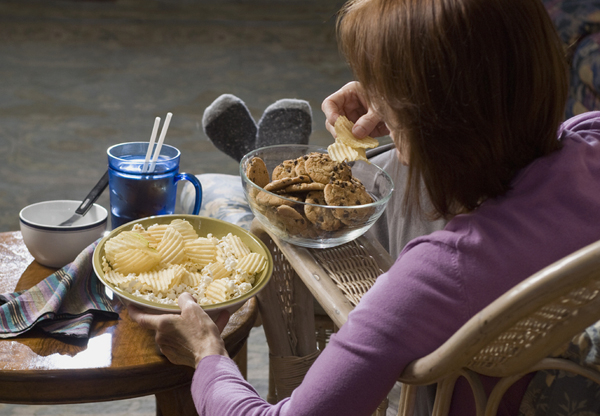25% of Calories Now Come from Snacks

Snacking is sneaking in more calories than ever before into our diets, new research says.
While the average American eats roughly the same amount of food during meals as in the 1970s, the number of calories Americans consume as snacks has increased to 580 calories per day, the equivalent of a fourth meal, said Richard D. Mattes, a professor of nutrition at Purdue University.
Time spent snacking has increased as well, and so has our daily intake of calorie-rich beverages, which now account for up to 50 percent of the calories we consume outside of meals, Mattes said.
"Snacking may be an important source of nutrients that we would like to increase in our diet," Mattes said. But when snacks become a source of excess calories, they contribute to obesity, he said.
Mattes presented the data at the meeting of the Institute of Food Technologists, an industry group, in Chicago on Monday.
A snacktacular increase
Between 1977 and 2006, the average daily consumption of snack calories increased from 360 to 580, Mattes said.
Get the world’s most fascinating discoveries delivered straight to your inbox.
Further, Americans are now more likely to slurp up calories in the form of sugary drinks. The percentage of Americans who consume calorie-rich beverages on a daily basis increased from 41 percent in 1965 to 67 percent in 2004, according to a 2009 study Mattes published in the American Journal of Clinical Nutrition. Beverages can account for up to half the calories Americans ingest outside of mealtimes, he said.
"Beverages have been marketed heavily," he told MyHealthNewsDaily. Now, "you can drink anywhere —in the classroom in a university, in a boardroom, driving in your car."
Thirty to 40 years ago, "preschoolers snacked once a day, adults consumed coffee or tea, and snacking was a very occasional event," said Dr. Barry Popkin, professor of nutrition at the University of North Carolina, who has collaborated with Mattes. "Salty snacks, sugar-sweetened beverages and all the other foods consumed as snacks contain far too many calories, and are helping to fuel the epidemic of obesity and diabetes."
But are snacks all bad?
Not all scientists agree that increased snacking is the culprit behind the current heightened obesity rate, however. "Foods consumed outside a meal are important sources of nutrients as well as energy," said Harvey Anderson, director of the Department of Physiology at the University of Toronto, who also spoke at the meeting.
"There are mixed data," Mattes acknowledged. Still, "it's my view that snacking is problematic when it is done in an unplanned or mindless sort of way, and when it contains a high proportion of beverages," he said.
"We need to reduce the number of snacks if we can. If not, the other option is to consume water, unsweetened tea and coffee, and fruit and vegetables only for snacks," Popkin said. "Marketing by the food industry has induced us to [eat more], and we are now eating without being hungry."
Pass it on: If you're counting calories, you may want to watch closely what you're eating and drinking between meals.
This story was provided by MyHealthNewsDaily, a sister site to LiveScience. Follow MyHealthNewsDaily on Twitter @MyHealth_MHND.
